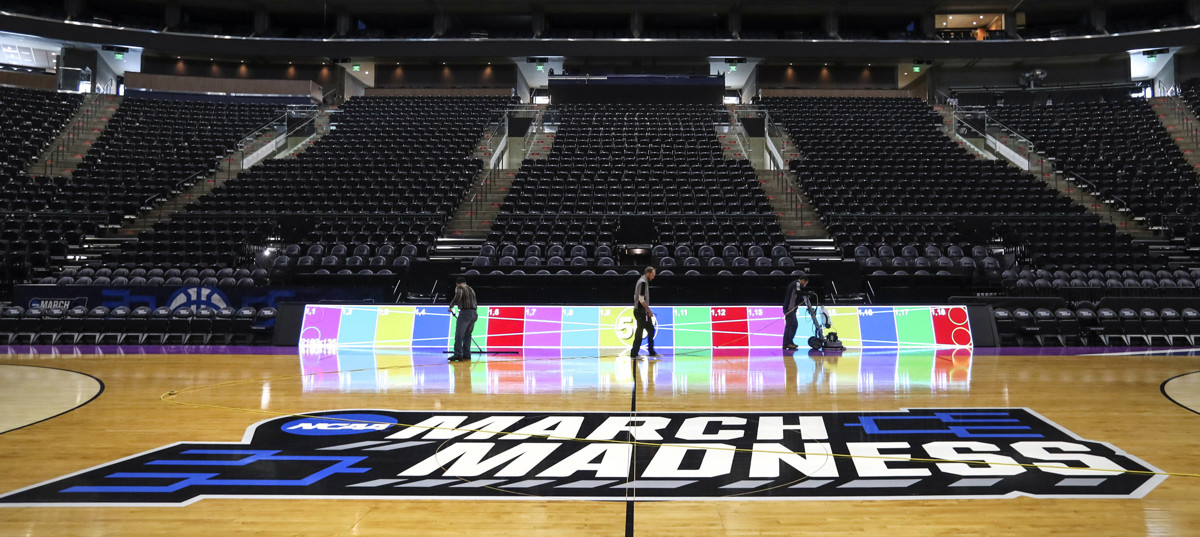The first weekend of the NCAA Tournament produced a lot of chalk. Fourteen of the top 16 teams advanced to the Sweet 16, with Oregon and Auburn as the only “bracket busters”, and even that term is generous. Auburn is a 5 seed and Oregon, despite being a 12 seed is probably the hottest team in the country and was a trendy Sweet 16 pick heading into the tournament. For the first time since the tournament expanded to 64 teams, all 16 betting favorites won their round of 32 matchups. Overall, every No. 1, 2, and 3 seed made it out of the first weekend. For the ACC, chalk is a good thing; the conference earned three No. 1 seeds, only the second time in history a conference achieved such a distinction. Aside from that trio, the ACC also had two No. 4 seeds, both of which are still alive. Of the seven ACC teams in the tournament field, only Louisville and Syracuse have been eliminated, leaving five in the Sweet 16. For reference, in 2016 the ACC set a tournament record with six teams in the Sweet 16. Let’s breakdown the successes and failures of the ACC teams in the tournament field.
The Losers: Louisville and Syracuse
The Cardinals were one of the hardest teams to predict in the field of 68. What was supposed to be a rebuilding year for Chris Mack turned into a successful one with the breakout of Jordan Nwora. By mid-February, Louisville looked like a potential sleeper Final Four team. The Cardinals had some losses, but those could be chalked up to a brutal non-conference schedule and an-always challenging ACC slate. Louisville had wins over Michigan State, Seton Hall, and a road win at Virginia Tech. The Cardinals also handed North Carolina its worse home loss in the Roy Williams era and led Duke by 20 before blowing the lead and losing by 2 points. Then came the end of the season; including the ACC tournament, Louisville lost 7 of its final 10 games to sputter into the NCAA Tournament. Some were close losses, like the Duke game, but the Cardinals also lost to Boston College and were blown out by Syracuse. In the opening round, Louisville just happened to run up against a team trending in the opposite direction, the Minnesota Golden Gophers. The Gophers put on a good showing in the Big 10 tournament and carrier the momentum over to the Louisville game. All five starters cracked double figures, including a game-high from underrated freshman Gabe Kalscheur. Nwora, who averaged 17 points per game for the Cardinals only scored 10 in the game. Louisville played from behind the whole game and, despite a late run, was sent home early, as the first team eliminated from the field of 64.
Syracuse appeared to be the team with the best shot to knock off a No. 1 seed during the first weekend of the tournament. The Orange played Baylor in the 8 vs. 9 matchup in the West, and the winner would face No. 1 Gonzaga. Syracuse proved last year that it was a team capable of exceeding expectations despite a low seeding. The zone defense Syracuse employs can stifle any opponent on any given night, giving the Orange a shot against the Zags. Only, Syracuse never got that shot. News broke the day prior to the first round matchup that senior point guard Frank Howard would miss the game; it was later reported that he had failed a drug test and was suspended indefinitely. Howard’s loss served as a warning sign for pundits who were high on the Orange, and the cause for concern was justified when Syracuse lost to Baylor 78-69. The Bears carved up the zone defense, shooting 47 percent from 3-point range and 54 percent overall. Without Howard, Syracuse had to shorten the bench, and fatigue played a factor down the stretch after the game was tied at 57 with a little under 10 minutes remaining.
The No. 1’s: Duke, North Carolina, and Virginia
The abundance of chalk wouldn’t have been so bad if there were at least some close games. While more early games were one-sided than is usually the case in March, No. 1 overall Duke gave fans one of the most unexpectedly exciting games of the tournament. After pulling away and defeating North Dakota State 85-62, Duke barely escaped against 9-seeded UCF. It was the matchup everyone wanted to see: athletic specimen Zion Williamson against 7-foot-6-inch Tacko Fall. The two teams traded buckets in the first half before a quick Duke run left the Blue Devils up by 8 at the half. Like was the case multiple times in the second half, UCF refused to quit and kept nailing big shots to hang tight with Duke. UCF led by 3 after BJ Taylor’s made free throws with 45 seconds left. After a miss, Duke got a second-chance opportunity, and Williamson drove through the lane to get a tough and-one bucket. In the process, Fall picked up his fifth foul. Duke trailed 76-75 with Williamson at the line. He front-rimmed the free throw, but RJ Barrett was able to corral the rebound against the non-7-foot-6 defenders and put it back up to give Duke the lead. Out of a timeout, Taylor drove to the right side and tried to kiss the ball off the glass. It rimmed around and out, but Aubrey Dawkins, who tied with Williamson for a game-high 32 points, came flying in for the tip-in. Again, however, the ball rolled around and out. Duke survived. Barely.
The road to a championship is never easy, but past failures are helping the Virginia Cavaliers succeed in the 2019 NCAA Tournament. Of course, Tony Bennett’s 2018 squad will forever be remembered as the first No. 1 seed to lose to a 16 seed. That loss can never be wiped away, but it is the reason the Cavaliers are still standing in the 2019 tournament because they don’t beat Gardner-Webb this year without the pain of UMBC last year. The Cavaliers went down 14 early and entered halftime down 6 against the Bulldogs in this year’s first-round matchup. De’Andre Hunter, the versatile big man who missed last year’s tournament, wrote a new narrative for the Cavaliers with a big second-half performance. Mamadi Diakite also stepped up offensively on a night where Kyle Guy and Ty Jerome combined for 23 points. The first round jitters out of the way, Virginia comfortably handled Oklahoma, holding the Sooners to 51 points in a classic display of Cavaliers defense.
North Carolina was really the only No. 1 seed of the trio to advance to the Sweet 16 without any real threats of danger. Iona hung tough against the Tar Heels in the first round before UNC pulled ahead in the second half and won by 15. Then UNC pummeled the upstart Washington Huskies 81-59 behind efficient offensive nights by Nassir Little, Coby White, and Luke Maye. The Tar Heels have the perfect mix of youth and experience to make a deep run in March. Little, who has 39 points in 38 minutes of tournament action, hasn’t been given the opportunity to shine like most had hoped for coming into the season, but the former top-5 recruit will be UNC’s x-factor over the next couple of weeks.
The Others: Virginia Tech and Florida State
Virginia Tech entered the NCAA Tournament as a 4 seed and had a relatively easy path to the Sweet 16. The Hokies beat Saint Louis in the first round and pulled away late against a scrappy Liberty squad. Against the Billikens, it was the usual suspects, Kerry Blackshear Jr. and Nickeil Alexander-Walker who carried the team offensively. Alexander-Walker struggled shooting in the second game, but Blackshear Jr. got scoring help from Ahmed Hill and Ty Outlaw. For Virginia Tech, the biggest development was the return of senior Justin Robinson from a foot injury. Robinson averaged 11 points off the bench in the first weekend of the tournament. Next up is Duke. Virginia Tech did defeat the Zion-less Blue Devils in Blacksburg a month ago. Will history repeat itself?
Like Virginia Tech, Florida State entered the tournament as a 4 seed. Also like Virginia Tech, Florida State faced a 12 and a 13 seed on the road to the Sweet 16. Unlike Virginia Tech, Florida State faced two Cinderella-worthy double-digit seeds: Vermont and Murray State. Propelled by junior Anthony Lamb, Vermont posed a threat as an excellent 3-point shooting team. The Catamounts gave the Seminoles a fight, but Florida State’s much-talked-about length gave Vermont fits late in the game and led to 16 Vermont turnovers in the 76-69 win for FSU. Murray State and freshman sensation Ja Morant awaited the Seminoles in the second round. While Morant finished the game with 28 points, the Seminoles dominated in a 90-62 victory. The road doesn’t get any easier, as the Gonzaga Bulldogs are the Seminoles Sweet 16 foe. Florida State is the team that eliminated the Zags in the Sweet 16 last March. As with Virginia Tech against Duke, the Noles are hoping history repeats itself.
Author Profile
Latest entries
 NCAABApril 5, 2019Method to the Madness: NCAA Tournament News
NCAABApril 5, 2019Method to the Madness: NCAA Tournament News ACCMarch 27, 2019Taking Stock of the ACC After the First Weekend of March Madness
ACCMarch 27, 2019Taking Stock of the ACC After the First Weekend of March Madness ACCMarch 19, 2019A look at the ACC in the NCAA Tournament
ACCMarch 19, 2019A look at the ACC in the NCAA Tournament ACCMarch 10, 2019BC Dominated By NC State on Senior Day
ACCMarch 10, 2019BC Dominated By NC State on Senior Day

